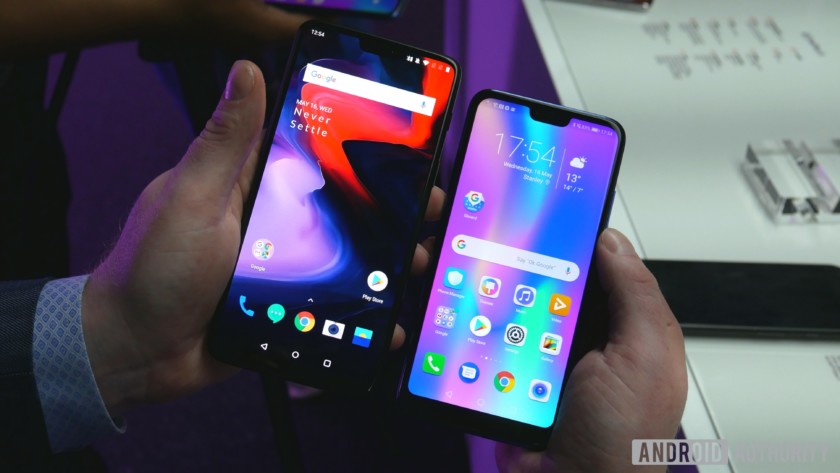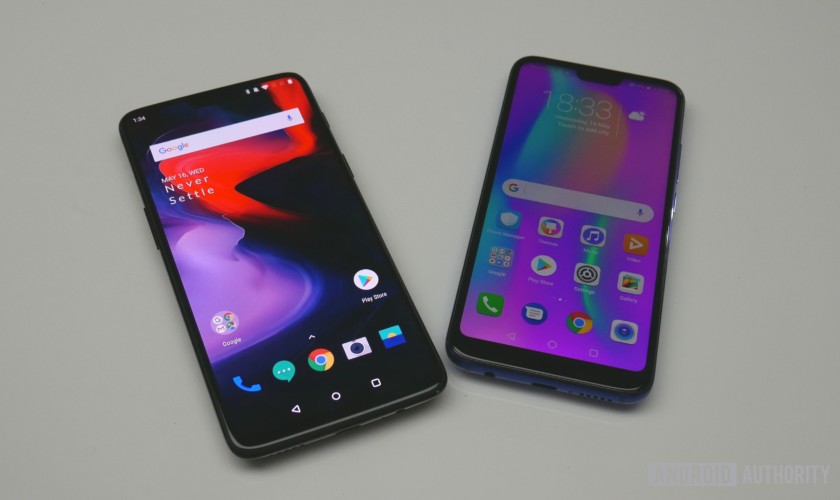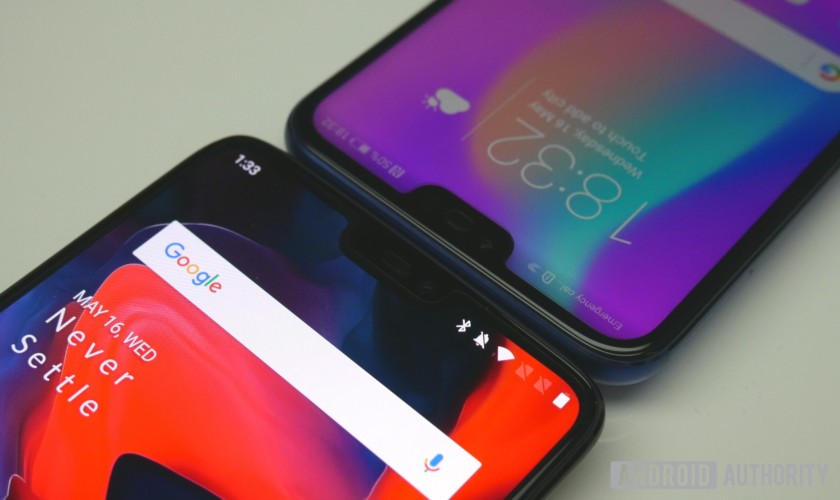The Honor 10 and OnePlus 6 occupy a similar space in the smartphone market. These are both affordable devices with flagship-esque specs. In both cases, you're looking at high-performance dual lens cameras, top-end chipsets, and tons of neat features. But there can only be one! Who shall rise victorious?
In terms of design, both devices look pretty similar at first. And the first thing that's likely to hit you in both cases is that these devices are pretty much all screen, with 19:9 ratios, and big old notches at the top. Now, if there's one thing I've learned working for Android Authority, it's that everyone loves a notch. Without exception.
Psych! Obviously, this is a divisive feature, but the good news is that you can eliminate that notch in both cases. So you can have your cake and eat it too.

The OnePlus 6 has a slightly bigger screen at 6.28 inches vs 5.84 inches on the Honor 10, but both are pretty generous in that regard. Overall, the OnePlus 6 display is the winner for two reasons: it's an AMOLED and is covered in Gorilla Glass 5. The Honor 10 doesn't specify what type of glass it uses, but it feels a lot softer and seems more prone to chips and scratches in my time with it so far. Both sport Full HD+ resolutions.
Overall, the OnePlus 6 display is the winner.
It's also worth noting that the Honor 10 has more of a chin on it, owing to the decision to place the fingerprint sensor around the front. It's true that this seemingly contradicts the choice of the notch design (removing as much bezel up top only to keep a chin for the fingerprint scanner below). The OnePlus 6 meanwhile keeps its sensor around the back, which is arguably the smarter choice.
That said, the Honor 10 does boast an ultrasonic fingerprint sensor, that claims to be faster and operate better even with wet fingers.
The Honor 10 also sports that dazzling "aurora glass" rear panel. Made from 15 layers of glass, it's quite a bold statement and shimmers in all kinds of different colors depending on the angle of the light hitting it. It won't be for everyone, but it certainly sets the Honor 10 apart as something different. That said, the OnePlus 6 is no slouch in the looks department either. It's also made completely from glass, with each color utilizing a different material finish and an overall very premium effect.
The Honor 10 is the more interesting and distinctive-looking of the two devices.
Neither device is IP certified, but they do both sport headphone jacks. Swings and roundabouts (that's British for "you win some, you lose some"). You may feel differently, but the Honor 10 is the more interesting and distinctive-looking of the two devices.

Specifications
As for the specifications, both these devices are running top-tier chipsets which is fantastic news at this mid-range price point. The Honor 10 has the Kirin 970, while the OnePlus 6 uses the Snapdragon 845. Both are the latest offerings from their respective manufacturers, but the Kirin 970 has been around relatively a little longer, and it shows in benchmarks. The 845 – and therefore the OnePlus 6 – is the superior performer when it comes to gaming and general smooth performance. The 970 is all about that NPU though, and this is what allows the Honor 10 to boast a number of advanced AI features (mostly involving the camera and memory management).
Both devices run top-tier chipsets and 128GB of storage, but the OnePlus 6 offers more RAM.
Either way, it's should be safe to say that you'll be very well served by either of these options in the horsepower department. The OnePlus 6 does have the edge in the RAM department though with an option between 6GB or even 8GB, versus just 4GB for the Honor 10.
| Honor 10 | OnePlus 6 | |
|---|---|---|
| Display | 5.84-inch FullView LCD Display 2,280 x 1080 resolution 19:9 aspect ratio | 6.28-inch AMOLED 2,280 x 1,080 resolution 19:9 aspect ratio Corning Gorilla Glass 5 Supports sRGB, DCI-P3 |
| SoC | HiSilicon Kirin 970 Octa-core, 10nm (2.36Ghz quad + 1.8Ghz quad) | Qualcomm Snapdragon 845 Octa-core, 10nm, up to 2.8GHz |
| GPU | Mali G72 MP-12 | Adreno 630 |
| RAM | 4GB/6GB | 6GB/8GB |
| Storage | 64GB/128GB Non-expandable | 64/128/256GB UFS 2.1 2-lane Non-expandable |
| Cameras | Rear Main camera: 16MP, f/1.8 aperture Secondary camera: 24MP, f/1.8 aperture, monochrome Front 24MP, f/2.0 aperture | Rear Main camera: 16MP, f/1.7 aperture, 1.22μm pixels Secondary camera: 20MP, f/1.7 aperture, 1.0μm pixels Front 16MP, f/2.0 aperture, 1.0μm pixels |
| Audio | Bottom-firing speaker 3.5mm headphone jack | Bottom-firing speaker Dirac HD Sound Dirac Power Sound 3.5mm headphone jack |
| Battery | 3,400mAh Non-removable SuperCharge (5V 4.5A) | 3,300mAh Non-removable Dash Charge (5V 4A) |
| IP Rating | No | No |
| Sensors | Fingerprint Hall Gyroscope Proximity Ambient light Digital compass Gravity sensor Status indicator IR blaster | Fingerprint Hall Accelerometer Gyroscope Proximity Ambient light Electronic compass Sensor hub |
| Ports | USB Type-C (USB 2.0) 3.5mm headphone jack | USB Type-C (USB 2.0) USB audio support 3.5mm headphone jack |
| Network | 4G LTE TDD: B38/B40/B41 4G LTE FDD: B1/B3/B5/B7/B8/B19/B20 3G WCDMA: B1/B2/B5/B8/B6/B19 2G GSM: B2/B3/B5/B8 | LTE: Supports 4xCA Supports 64QAM, 256QAM, up to DL CAT 16 (1Gbps)/UL CAT 13 (150Mbps) depending on carrier support Bands: FDD LTE: Bands 1/2/3/4/5/7/8/12/17/18/19/20/25/26/28/29/30/32/66/71 TDD-LTE: Bands 34/38/39/40/41 TD-SCDMA: Bands 34/39 UMTS (WCDMA): Bands 1/2/4/5/8/9/19 CDMA: BC0/BC1 GSM: 850/900/1800/1900MHz |
| Connectivity | Wi-Fi: 802.11 a/b/g/n/ac, 2.4GHz/5GHz Bluetooth 4.2 NFC GPS, AGPS, GLONASS | Wi-Fi: 2x2 MIMO, 802.11 a/b/g/n/ac, 2.4G/5G Bluetooth 5.0 aptX/aptX HD support NFC GPS, GLONASS, BeiDou, Galileo |
| Software | Android 8.1 Oreo EMUI 8.1 | Android 8.1 Oreo OxygenOS |
| Dimensions and weight | 149.6 x 71.2 x 7.7mm 153g | 155.7 x 75.4 x 7.75mm 177g |
| Colors | Phantom Blue, Phantom Green, Midnight Black, Glacier Grey | Mirror Black, Midnight Black, Silk White |
| SIM | Dual nano SIM | Dual nano SIM |
Both come with 128GB of storage – again you can bump that up to 256GB with the OP6 – but you won't be able to expand that storage at all in either case, unfortunately.
It's worth mentioning that the OnePlus 6 is also a little snappier thanks to its near-stock version of Android. With OxygenOS it's not quite stock, but it's certainly a lot less bloated than the EMUI 8 on the Honor 10. A lot of people don't like EMUI 8 and I count myself among them – but fortunately, most of the stylistic choices at least can be eliminated with a new launcher and a few other customizations.
As for software, it all depends on whether you like tons of features or a leaner interface.
This will be a matter of opinion, but I think for many, the software experience on the OnePlus will be the preference. It all just depends on whether you like tons of software features or a leaner and cleaner interface.
Both devices are very similar in terms of battery: the OnePlus clocks in at 3,300mAh, while the Honor 10 squeezes in just a tiny bit more juice with a 3,400mAh cell. They both have fast charging but neither has wireless support despite having a glass back.

Camera
Finally, the cameras. We have a dual lens set-up in both cases. You get an iPhone-like vertical array on the OnePlus and a more original horizontal layout for the Honor. In terms of the specs, the OnePlus 6's main camera is 16MP with a nice wide aperture of f/1.7. It features both EIS and OIS and is backed up by a secondary 20MP sensor. It can do super-slow-mo and record video up to 4K at 60fps. Like nearly every camera these days, it can also do a portrait mode effect.
The Honor 10 meanwhile comes with a 24MP rear camera, backed up by a secondary 16MP lens – so it wins on the megapixel front. It has a slightly narrower aperture at f/1.8 but, in a bigger disappointment, it has no optical stabilization. It does feature some impressive AI photography tricks, which allow it to do things like recognizing flowers or food in shots in order to adjust the settings for the best effect. Your mileage may vary in terms of how beneficial this is, however.
Ultimately, which of these is the better camera might well come down to your priorities and personal preference.
What Honor also brings to the table and what is often overlooked, is a smorgasbord of cool options and features, including my favorite long exposure mode for light painting and star tracking.
Ultimately, which of these is the better camera might well come down to your priorities and personal preference. Both do a great job either way, and especially for the price point.
Both phones also have decent front-facing cameras too: the OnePlus 6 sports a very respectable 16MP, while the Honor 10 boasts an even more impressive 24MP.

And the winner is…
So, to wrap up, what are we looking at here?
First of all, we're looking at two incredibly great phones for the asking price. When I reviewed the Nokia 7 Plus I thought that was crazy good value. Then came the Honor 10 with its near flagship looks and performance. And then the OnePlus 6…
The bottom line?
Samsung, Google and Apple are going to have to work extra hard next year to justify their price points or introduce some serious innovation.
A strong argument could be made for either of these phones, but the OnePlus 6 comes out on top for me.
Both of these are fantastic phones and a strong argument could be made for either – it will largely come down to personal preference and which features matter most to you. For example, I love the light painting and star tracking modes on Honor phones so much that that feature alone is almost enough to win it for me. But I'm probably alone in that. For others, it'll be looks, or software or battery life.
Of course, declaring an absolute winner in a comparison like this is folly. Not only is this entirely a matter of opinion, but it's also a sure fire way to get a huge number of angry comments on an article. Nevertheless, I'm not just here to share British sayings with you: the OnePlus 6 is the winner in my books.
from Android Authority https://ift.tt/2J1dwyP
via IFTTT


Aucun commentaire:
Enregistrer un commentaire